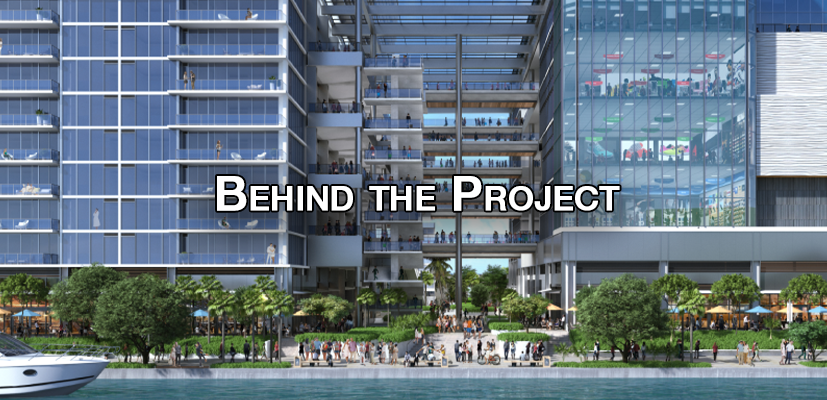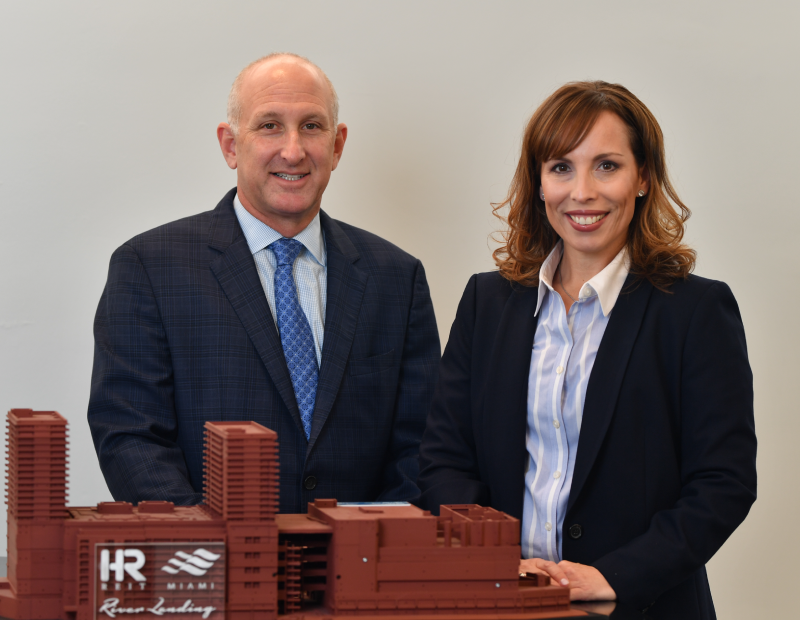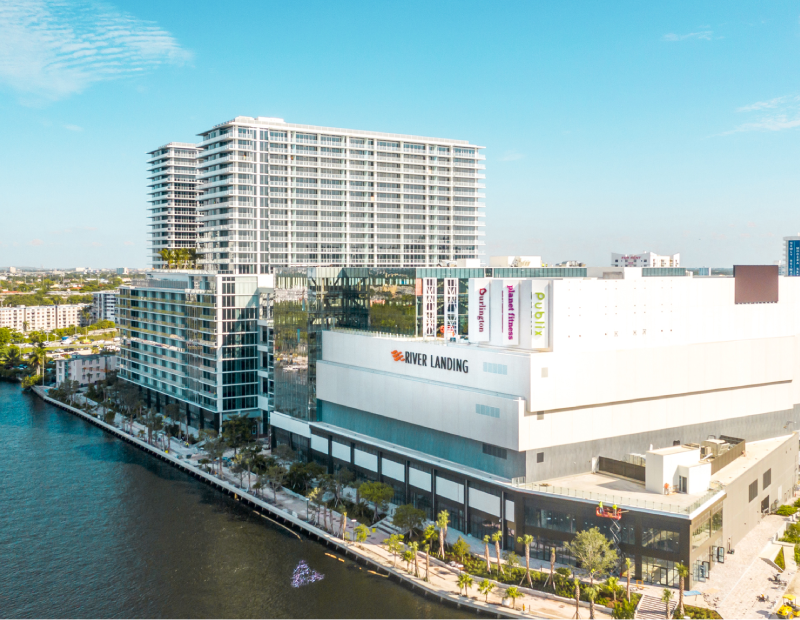Retail’s Flexibility, Versatility in Pandemic Times
River Landing’s developer shares his views on the project’s success in a post-COVID-19 world.
The $424.8 million River Landing Shops & Residences project along the Miami River, west of downtown Miami is currently one of the largest mixed-use developments in South Florida. Upon completion, the 2.2 million-square-foot modern urban lifestyle property will offer 345,000 square feet of commercial space—including 25,500 square feet of waterfront dining space, 528 market-rate apartments and more than 2,000 parking spaces. Additionally, the project will include various experiential and open-air spaces.
The developer behind the project, co-Principal Andrew Hellinger of Urban-X Group, discusses how the retail architectural trends of the last decade are playing a key role in helping restore shopper confidence in a post-COVID-19 world. Hellinger also talks about how he and his colleague Coralee Penabad designed the project to draw patrons in the age of e-commerce.
READ ALSO: The Future of Retail in a COVID-19 World
What is the current status of the River Landing Shops & Residences project?
Hellinger: We are weeks away from completing construction and welcoming our first retail tenants at River Landing Shops & Residences. We expect our other retail tenants, such as Ross Dress for Less, Burlington and Five Below, to open together in the fall, and the balance of our anchors in early 2021 when limits on capacity are greater than they are currently. Some of the retail tenants that will be opening in the coming months include Burlington, AT&T, Old Navy, Chick-fil-A and Hobby Lobby. The 2.2 million-square-foot mixed-use development at 1400 NW North River Drive is located between downtown Miami to the east and Miami International Airport to the west.
We are also building a 135,000-square-foot urban lifestyle, Class A office building. We expect tenants to begin moving in in late 2020. The office building is LEED-certified and features floor-to-ceiling exterior impact glass, offering views of the historic Miami River, the Atlantic Ocean and Miami’s skyline. In case of an emergency, the building provides a full-service commercial generator to power the offices.
Please talk about the innovative aspects of the project.
Hellinger: We designed River Landing to be a smart complex, working with technology in nearly every aspect of the project. This includes installing a smart garage system that will auto-charge vehicles once visitors open an account with us, making it easier for guests to visit. The system utilizes touchless pay technology where visitors can use an app on their phones to settle their accounts.
River Landing has also partnered with Liquid Outdoor to provide smart kiosks and digital screens that assist in wayfinding, security, selfie cameras, public safety alerts and messaging. Liquid Outdoor’s synergistic partnership with Samsung enables advanced technology solutions that can be implemented and updated as new platforms become available across the project. We are also installing smart lockers for guests and tenants and have folded in ridesharing technology, such as Uber and Lyft, into the project.
Have you changed your initial plans for the commercial part of the project due to the coronavirus crisis?
Hellinger: The coronavirus pandemic has impacted our plans for the project in several ways. First, it delayed our opening as we had to implement proper health, safety and social distancing measures on the construction site. Secondly, we adopted our plans to meet the new realities of the world and the emerging business model. For instance, we are implementing features such as curbside pick-up spaces for our tenants to continue to meet customer demand while promoting social distancing.
On the office side, we have been adaptable as tenants now look for larger open plates to incorporate social distancing between employees in their design. Yet, the office space was designed to encourage collaboration among teams. The building provides a full-service commercial generator to power the offices.
The office’s state-of-the-art amenities also allow socialization at a distance in an open-air setting for safety reasons. For example, office tenants will have access to a private 17,000-square-foot outdoor plaza, an 850-foot waterfront linear park and green space.
What are the greatest challenges when designing the retail component of a project of this magnitude?
Hellinger: The greatest challenge is to be adaptable. The retail industry and urban development have evolved greatly since Coralee and I first began to plan and develop River Landing coming out of the Great Recession a decade ago. As such, we designed River Landing to be both sustainable and adaptable to whatever the future may hold. One example of this is creating flat parking in our connected garage to be able to convert the area into new residential units in the future, as use of automobiles and demand for parking drops. Being able to be flexible is one of the design aspects that makes our project stand out.
Listening to our tenants and their customers’ needs is also paramount. As retailers adapt to the challenges of the market, River Landing is creating an environment for them to be successful. Incorporating technology into our center and designing outdoor spaces that contribute to place-making principles and prolong a visitor’s stay are some of the ways in which River Landing is meeting the challenges of the retail marketplace.
The rise of e-commerce has impacted many retailers. How will River Landing Shops & Residences draw patrons in the age of e-commerce?
Hellinger: River Landing is designed to be an experiential marketplace and a community hub as people naturally tend to gather on Miami’s waterfront. Since the earliest days of human civilization, the marketplace has been a focal point for community gathering and will continue to do so even with the emergence of e-commerce. For example, River Landing will include a 25-foot-wide Riverwalk so that visitors and community residents can enjoy the Miami River. We will also feature a 25,000-square-foot restaurant row along the River with signature restaurants and memorable one-of-a-kind experiences for visitors.
We have also sought out retail tenants that offer shoppers items that cannot be found online. Retailers such as T.J. Maxx, Ross Dress for Less, Burlington Coat Factory and Old Navy all have in-store exclusives that allow visitors to take part in the “treasure hunt” shopping experience that cannot be found in an online environment.
How have architectural trends changed in the retail sector over the past decade?
Hellinger: Over the past 10 years, retail has become more about providing a shopper with a unique experience, and retail architecture has changed to reflect this. Rather than just a big box for tenants, retail developments now must create a vibrant and dynamic atmosphere for visitors in order for them to continue to come back. It has to be more than just about shopping. That is what we have done by incorporating the Miami River into our project. We have designed a large open, outdoor atrium that connects the two sides of our retail project that will create a communal space for residents and visitors but is also large enough to maintain social distancing in current times.
The architectural environment is designed to encourage visitors to extend their stay and participate in our outdoor spaces. The architecture is a backdrop to enjoying South Florida’s excellent year-round climate and our ability to engage on the waterfront. Merging interior and exterior environments and allowing our retailers to extend into our riverfront patio and atrium spaces enhances the overall customer experience.
READ ALSO: Retail’s Reemergence: ‘Adapt, Evolve, Innovate or Perish’
What role do these new trends play in restoring shopper confidence in a post-COVID-19 world?
Hellinger: While we believe there will be a pent-up demand for retail post-COVID-19, it is important that shopping centers instill consumer confidence into their safety protocols. Large-scale projects, such as River Landing, that offer open and outdoor spaces will likely see a return of visitors first. We anticipate consumers will want to stay away from enclosed shopping environments for fear of the virus spread. Developments that have embraced the open-air concept over the past 10 years will be better-positioned moving forward.
Given consumers, for the most part, have stayed at home throughout this pandemic, the demand for experiences will only grow as consumers learn to live in the new normal imposed by COVID-19.
How do you feel about the future of the retail sector in Miami?
Hellinger: The future of retail in Miami continues to look strong. Miami’s robust retail culture is not disappearing through the pandemic, and in fact, demand is only building. After the pandemic, we expect a surge of guests as Miami residents and visitors seek retail therapy after months of staying home. Miami will also benefit from a pent-up demand from international travelers who haven’t been able to visit South Florida to shop as they normally do. In our region, it is normal for Latin American tourists to arrive at Miami International Airport with empty luggage, so they can shop at discount department stores and fill their luggage up. That phenomenon is truly unique to our market.












You must be logged in to post a comment.